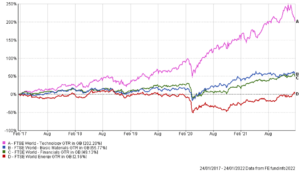 We are now in the midst of another volatile period in investment markets and the inevitable questions are starting to come through from clients as to what is going on. Global stock markets have undergone a correction in recent weeks, while the FTSE 100, which consists of the UK’s largest companies, is moving higher and is back to pre-pandemic levels. What is causing this divergence?
We are now in the midst of another volatile period in investment markets and the inevitable questions are starting to come through from clients as to what is going on. Global stock markets have undergone a correction in recent weeks, while the FTSE 100, which consists of the UK’s largest companies, is moving higher and is back to pre-pandemic levels. What is causing this divergence?
The answer behind this behaviour is two-fold: (1) inflation and interest rate expectations, and (2) the way in which global stock markets are constructed.
Looking at point (1) first. Coming into 2021, inflation in the UK was running close to zero, driven down by lower levels of spending during the third Covid lockdown. However, an increase in consumer spending following the easing of lockdown restrictions in summer, rising wholesale energy prices, global supply chain issues (and, specific to home, increased trade friction between the UK and EU due to Brexit) has pushed up prices, such that inflation is now at its highest levels for many years. This spike (not just in the UK but also in the US, Europe and elsewhere) has caused concerns that central banks worldwide will have to step in and raise interest rates to bring it under control.
Now onto point (2). No two markets are constructed in the same way in terms of the sectors within them, meaning each one moves differently depending on market conditions.
Simplistically, sectors within a stock market can be split into two buckets: ‘value’ and ‘growth’. Value stocks typically operate in ‘old economy’ industries (e.g. miners, oil & gas companies), that consequently tend to pay out more of their earnings to investors as dividends, rather than reinvesting back into the business. On the other hand, ‘growth’ stocks are those in rapidly expanding industries with strong future earnings potential (e.g. technology) – to generate these returns and stay ahead of their competitors, they tend to reinvest their profits into the business and pay less in the way of a dividend (if at all), and some may have borrowed money for future expansion.
Increases in interest rates (and expectations thereof) are a catalyst supporting a positive outlook for value stocks, as investors place more emphasis on the earnings they generate today (i.e. the dividend), so they are relatively immune from higher interest rates. Conversely, growth stocks traditionally underperform in these conditions as more emphasis is placed on their long-term prospects, which could be eroded by inflation (and, if they have borrowed money, higher borrowing costs).
Notably, the UK’s FTSE 100 predominantly has more ‘value’ businesses, with Materials (e.g. miners Rio Tinto and BHP Group), Energy (e.g. BP and Royal Dutch Shell) and Financials (particularly high street banks) making up a large chunk of the index. On the other hand, the S&P 500 in the US is more of a ‘growth’ market, with technology (e.g. Facebook, Apple, Netflix) representing about a quarter of the index.
The table below shows the breakdowns of the FTSE 100 and the S&P 500 indices in percentage terms, and the differences between them in the right-hand column. The subsequent performance chart shows how the Materials, Energy, Financials and Technology sectors have performed over the past five years.
| Sector | FTSE 100 | S&P 500 | Difference |
| Consumer Staples | 18.4 | 6.7 | 11.7 |
| Materials | 13.4 | 2.3 | 11.1 |
| Energy | 11.0 | 3.3 | 7.7 |
| Financials | 17.0 | 13.6 | 3.4 |
| Utilities | 3.5 | 2.6 | 0.9 |
| Industrials | 8.8 | 8.4 | 0.4 |
| Real Estate | 1.3 | 2.7 | -1.4 |
| Healthcare | 11.9 | 13.3 | -1.4 |
| Communication Services | 6.6 | 10 | -3.4 |
| Consumer Discretionary | 7.3 | 11.7 | -4.4 |
| Information Technology | 0.1 | 25.4 | -25.3 |

Importantly, though, our portfolios are not – and never have been – the FTSE 100. Rather, they are diversified geographically, by sector, asset class, investment style, company size, fund house and other considerations, in order to reduce the amount of risk that our clients are exposed to, while aiming to provide them with optimum long-term investment returns. This means that our portfolios have exposure to the UK, as well as the likes of the US, Asia and Emerging Markets (all of which are more ‘growth’ oriented areas).
Following on from this, it is worth noting that it was the US/technology, Asia and Emerging Markets that powered the returns of 2020. While they have had a more difficult time of late, and there is likely to be heightened volatility in the months ahead (primarily linked to expectations around inflation and interest rates), we remain positive on the outlook from current levels. Firstly, the growth of technology companies over the past decade or so has been incredible, and the digital transformation of many sectors (e.g. electronic payments, online shopping, cybersecurity, among many others) seems to be far from over. We have also identified Asian and Emerging Markets (where the middle/consumer class continues to increase considerably in size) for strong potential returns over the next 5+ years. More generally, the funds within our portfolios are invested in high-quality companies with strong brands and pricing power, which puts them in strong positions to pass on price rises to consumers/their suppliers, thus providing a degree of inflation protection over the long term.
All in all, we therefore believe that our portfolios are well-positioned to benefit from these longer-term trends.



